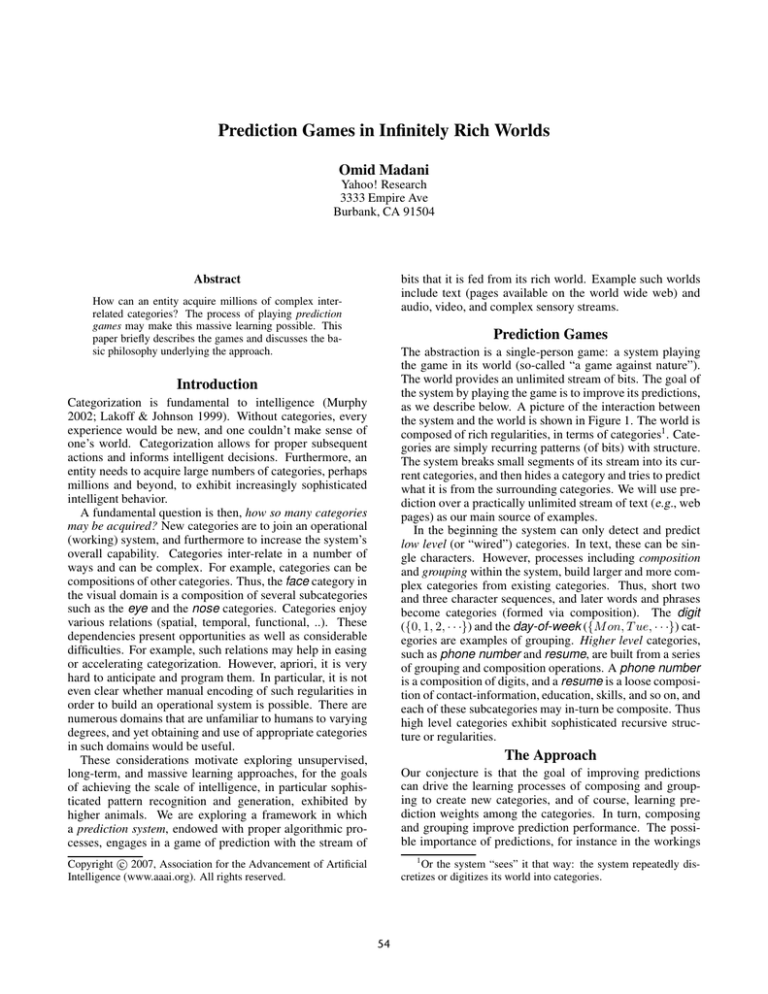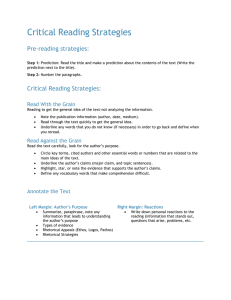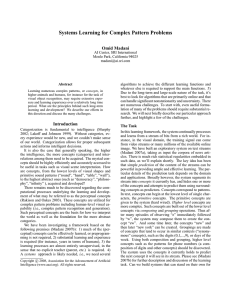
Prediction Games in Infinitely Rich Worlds
Omid Madani
Yahoo! Research
3333 Empire Ave
Burbank, CA 91504
bits that it is fed from its rich world. Example such worlds
include text (pages available on the world wide web) and
audio, video, and complex sensory streams.
Abstract
How can an entity acquire millions of complex interrelated categories? The process of playing prediction
games may make this massive learning possible. This
paper briefly describes the games and discusses the basic philosophy underlying the approach.
Prediction Games
The abstraction is a single-person game: a system playing
the game in its world (so-called “a game against nature”).
The world provides an unlimited stream of bits. The goal of
the system by playing the game is to improve its predictions,
as we describe below. A picture of the interaction between
the system and the world is shown in Figure 1. The world is
composed of rich regularities, in terms of categories1. Categories are simply recurring patterns (of bits) with structure.
The system breaks small segments of its stream into its current categories, and then hides a category and tries to predict
what it is from the surrounding categories. We will use prediction over a practically unlimited stream of text (e.g., web
pages) as our main source of examples.
In the beginning the system can only detect and predict
low level (or “wired”) categories. In text, these can be single characters. However, processes including composition
and grouping within the system, build larger and more complex categories from existing categories. Thus, short two
and three character sequences, and later words and phrases
become categories (formed via composition). The digit
({0, 1, 2, · · ·}) and the day-of-week ({M on, T ue, · · ·}) categories are examples of grouping. Higher level categories,
such as phone number and resume, are built from a series
of grouping and composition operations. A phone number
is a composition of digits, and a resume is a loose composition of contact-information, education, skills, and so on, and
each of these subcategories may in-turn be composite. Thus
high level categories exhibit sophisticated recursive structure or regularities.
Introduction
Categorization is fundamental to intelligence (Murphy
2002; Lakoff & Johnson 1999). Without categories, every
experience would be new, and one couldn’t make sense of
one’s world. Categorization allows for proper subsequent
actions and informs intelligent decisions. Furthermore, an
entity needs to acquire large numbers of categories, perhaps
millions and beyond, to exhibit increasingly sophisticated
intelligent behavior.
A fundamental question is then, how so many categories
may be acquired? New categories are to join an operational
(working) system, and furthermore to increase the system’s
overall capability. Categories inter-relate in a number of
ways and can be complex. For example, categories can be
compositions of other categories. Thus, the face category in
the visual domain is a composition of several subcategories
such as the eye and the nose categories. Categories enjoy
various relations (spatial, temporal, functional, ..). These
dependencies present opportunities as well as considerable
difficulties. For example, such relations may help in easing
or accelerating categorization. However, apriori, it is very
hard to anticipate and program them. In particular, it is not
even clear whether manual encoding of such regularities in
order to build an operational system is possible. There are
numerous domains that are unfamiliar to humans to varying
degrees, and yet obtaining and use of appropriate categories
in such domains would be useful.
These considerations motivate exploring unsupervised,
long-term, and massive learning approaches, for the goals
of achieving the scale of intelligence, in particular sophisticated pattern recognition and generation, exhibited by
higher animals. We are exploring a framework in which
a prediction system, endowed with proper algorithmic processes, engages in a game of prediction with the stream of
The Approach
Our conjecture is that the goal of improving predictions
can drive the learning processes of composing and grouping to create new categories, and of course, learning prediction weights among the categories. In turn, composing
and grouping improve prediction performance. The possible importance of predictions, for instance in the workings
c 2007, Association for the Advancement of Artificial
Copyright Intelligence (www.aaai.org). All rights reserved.
1
Or the system “sees” it that way: the system repeatedly discretizes or digitizes its world into categories.
54
categories
passage
categories
passage
011101010011110000010110
1. Predict
2. Observe & Update
1. Predict
Prediction System
2. Observe & Update
Prediction System
useful
categories
useful
categories
Figure 1: The world as an infinite stream of bits. The prediction system begins by “seeing” the world at low level categories
(recurring patterns), 0’s and 1’s here. With experience (learning), the prediction system sees the world as a stream of “bigger”
categories (bigger chunks) as well, and may play the game at multiple levels. Seeing means predicting the next category and
then (often) determining whether the prediction was true by observation (matching) and updates.
of the brain, has been much high lighted before (e.g., (Ballard 2000; Hawkins & Blaskeslee 2004)).
We also expect that these functionalities require highly
scalable learning, and thus space and time efficient, and
noise tolerant algorithms are important. Reasons for requiring scalability include the number of useful categories to
acquire as well as the challenges of uncertainty and drift.
The learning processes should remain robust for long durations as the learning will be sequential, cumulative, and
long-term. Due to these considerations, we expect that a
systems approach is most suitable in thinking about the solution. The system is composed of multiple algorithmic process that should work in concert. The system will be functioning primarily online, in order to be able to consume the
data necessary for the learning.
There are numerous challenges in achieving this functionality (Madani 2007b), but important observations and conjectures that make us optimistic include:
Potential applications are numerous: a prediction system, after a sufficient learning period (in order of days to
years, in human terms), becomes a highly capable pattern
recognition and generation machine. Thus, notable potentials include extending the reach of current language modeling techniques (Rosenfeld 2000), achieving general visual
object recognition (Forsyth & Ponce 2003), and generating
intericate physical motion. Higher intelligence such as sophisticated reasoning may also rest heavily on repeated use
of such inductively-obtained subsystems. We expect that the
problems formulated and solved will also shed insight on the
learning that is taking place in higher animals during their
development.
References
Ballard, D. H. 2000. An Introduction to Natural Computation.
The MIT Press.
Callebaut, W., and Rasskin-Gutman, D., eds. 2005. Modularity:
Understanding the Development and Evolution of Natural Complex Systems. The MIT Press.
Forsyth, D. A., and Ponce, J. 2003. Computer Vision. Prentice
Hall.
Hawkins, J., and Blaskeslee, S. 2004. On Intelligence: How
a New Understanding of the Brain will lead to Truly Intelligent
Machines. Owl Books.
Lakoff, G., and Johnson, M. 1999. Philosophy in the Flesh: the
Embodied Mind and Its Challenge to Western Thought. Basic
Books.
Madani, O. 2007a. Exploring massive learning via a prediction
system. In AAAI Fall Symposium Series,.
Madani, O. 2007b. Prediction games in infinitely rich worlds.
Technical report, Yahoo! Research.
Murphy, G. L. 2002. The Big Book of Concepts. MIT Press.
Rosenfeld, R. 2000. Two decades of statistical language modeling: Where do we go from here? IEEE 88(8).
Simon, H. A. 1996. The Sciences of the Artificial. The MIT Press,
third edition.
1. Rich worlds provide ample experience sufficient for massive learning (of millions of categories and their relations).
2. Rich worlds enjoy the type of simplifying regularities that
allow for efficient learning.
We expect that the hierarchical properties and near decomposability of complex categories (Callebaut & RasskinGutman 2005; Simon 1996) may allow for a type of efficient
learning that is in part “bottom up”. Much has been learned
from machine learning research to date. This should provide some guidance, in terms of what may be feasible, and
what task formulations to avoid. However, we also expect
that a number of new problems are to be formulated and effectively tackled, in designing and understanding prediction
systems. We believe that building and exploring such systems to better expose the issues should be very fruitful at
this point. In our recent work, we describe a system that
achieves some of the functionality, and further discuss current research directions (Madani 2007a).
55







